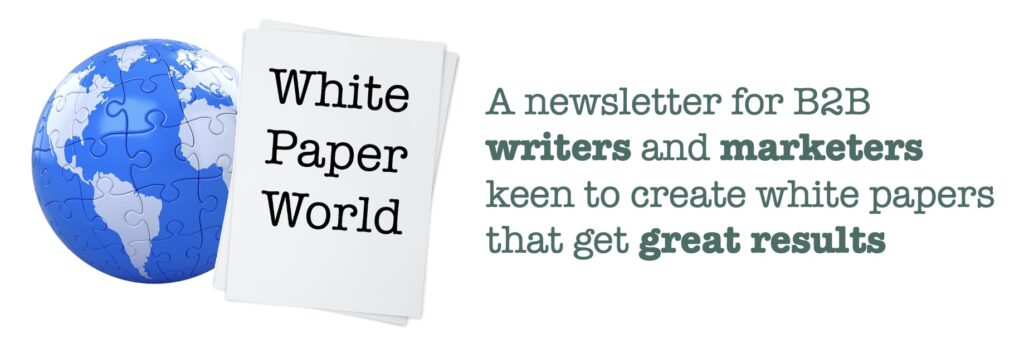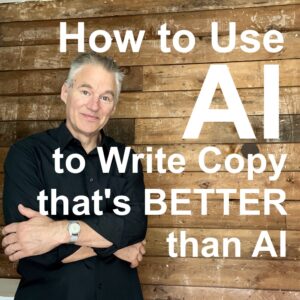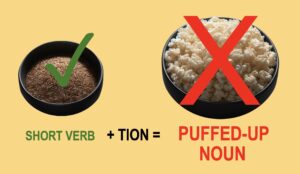
White Paper World 32: November 15, 2023
- Quick tip: Don’t start your next white paper like this
- Guest post: AI is like a microwave oven
- New course: How to use AI to write white papers, plus a special discount
- November Book Giveaway: What’s your best hack for ChatGPT?

Quick tip: Don’t start your white paper like this
Too many white papers suffer from what I call “throat-clearing.”
That’s when a paper begins by repeating something the audience already knows.
Consider this example from a white paper from HP:
Rapid innovations in Internet and mobile computing technology are drawing many communications, media, and entertainment (ME) companies to expand into profitable new markets to satisfy consumers’ growing appetites for digital content and web-based services.
Assuming you can parse that run-on sentence without falling into a stupor, who could disagree?
But what does that add to the paper?
Journalists call this “burying the lead”—not starting where the story really starts.
Sure, get warmed up… then delete the throat-clearing
Many writers get warmed up by jotting down a few well-known statements.
These often include a generic comment on the state of the economy or a certain market space.
It’s okay to get warmed up in your first draft. But I suggest cutting out the throat-clearing as soon as you notice it.
Find the point where you say something new and unexpected, and start your white paper there.
A real-world example
Here’s an extended example of throat-clearing I came across in a report on how people feel about AI.
Published by Gallup and a branch of the insurer Lloyd’s of London, this report draws on surveys from all over the globe.
Originally from 2021, this is being updated for 2024.
And it’s pretty interesting once you get into it.
But they don’t make that easy.
That’s because this report starts with a rousing chorus of throat-clearing.
You can click the thumbnail to view the Preface and see what I’m talking about.
Here’s the first sentence:
“We live in an age of rapid advancements in digital technology and interconnectivity.”
Sure. But this is so obvious it goes without saying.
Did we mention that horse-drawn buggies have been replaced by cars?
Next sentence: “This rapid change was accelerated by the Covid-19 pandemic, which pushed more people and activities online.”
Again, no argument. But why tell me something I know?
Third sentence: “These advances have demonstrated great value and offer opportunities to drive economic growth and higher living standards globally.”
Oh no, my eyes are starting to glaze over.
The next sentence talks about “existing inequities” without defining what that means.
And finally, we’re treated to two paragraphs that recap the foundation’s mission and why they do these reports.
Sure, this should be included somewhere. Why not in a section called About Lloyd’s Register Foundation at the back?
In the download, I redlined the first 170 words—half the page—to show everything I consider throat-clearing.
The Preface finally gets down to business in the fourth paragraph:
“This report focuses on two main areas…”
But I think that’s too little, too late.
By then, any reasonable reader has skipped on to the next screen. Wouldn’t you?

The real danger of throat-clearing
When you indulge in throat-clearing, you throw away your best chance to engage a reader.
You start your piece with bland, boring nothingness.
You force your readers to ride along as you get your thinking in gear and drive through the same old back roads they’ve seen a thousand times before.
Instead, why not treat them to a brisk, refreshing view of something new on the landscape?
Start your piece in top gear, and give your readers a ride they’ll remember.
Remember: To get people’s attention, show them something new.

Guest post: AI is like a microwave oven
by Brian Boys
I was a little kid when microwave ovens first came out.
They were going to change the way we all prepared food. The traditional stove was now obsolete!
After all, a microwave could cook something in minutes that would take a human chef hours. So all conventional ovens were soon going to be replaced.
I remember seeing a big cookbook that showed how to cook everything for your Thanksgiving dinner in your microwave, including the turkey.
What do you use your microwave for now?
Today, we use ours to heat water for tea. And to warm up leftovers.
But to cook a real meal, we still have a stove with a traditional oven. Don’t you?
It turns out those conventional ovens were never obsolete after all.
Instead, microwave ovens became just another appliance in any kitchen. They settled into their niche and became indispensable for some things… but not for everything.
And life went on for skilled cooks.
AI may settle into a niche, just like the microwave
These days, we often hear that AI bots like ChatGPT are going to change the way we all write content. The traditional writer is now obsolete!
After all, AI can write something in seconds that would take a human writer hours. So all human writers are soon going to be replaced.
I’ve been testing these artificial copywriters, and I’m not so sure.
What the bot spits out is pretty good—at least sometimes.
As with any transformative technology, there’s a lot of hype in the beginning. And I’m positive the technology is going to get better.
But what if it turns out that human writers never go obsolete? What if AI becomes just another tool in any office?
What if today’s AI chatbots settle into their niche, just like microwaves did, and become indispensable for some things… but not for everything?
Will human writers always be needed?
We know generative AI is good at spewing out content.
But remember that the whole purpose of content is:
A) to entice somebody to read it and
B) to influence their thinking.
Right now, for an AI bot to do this, a skilled human has to provide several steps:
- The AI must be strategically prompted.
- The output must be carefully edited so it sounds like a real person.
- And that content must be checked for accuracy by someone who knows the subject well.
If you’ve seen the copy some people are posting on their blogs and emailing to their lists without doing these steps, you’ve seen what amounts to a turkey cooked in a microwave.
Does that mean skilled writers can simply carry on, secure in the belief that we will always be needed?
Not exactly.
Three steps to help make the transition to AI
If you’re a copywriter or a content writer, you can’t afford to ignore AI.
You need to purposely build the skills to use AI in your writing process.
Here are three big things you need to do:
- Make the transition.
Learn more about AI and how to benefit from what it can do today. Experiment. Try it out for different things, just like those early cooks tried out microwaves for different things. - Become a resource.
Be the person your boss or client can talk to about this. Get familiar with the strengths and weaknesses of AI so you can give good advice and offer valuable insights. - Realize that working with AI can be fun.
It’s a lot like cooking: You can tweak your prompt recipes to get the results you want. But it’s faster than cooking because you can try again in another 10 seconds.
If you carry out this recipe, you’ll know more about AI than most writers.
You’ll get better results from it. And you’ll know what it can do well and what you can do better.
For example, don’t even think about cooking your Thanksgiving dinner with AI! Some things will always be better done the old-fashioned way.
Brian Boys is a seasoned content writer who has developed cool training tools to share his knowledge with other writers. See the next item for his latest creation.

New course: How to use AI to write white papers, plus a special discount
To help writers make the jump to AI, Brian Boys has created an excellent program called “How to Use AI to Write Copy that’s BETTER than AI.”
I’ve gone through it, and I highly recommend it!
What’s in this course?
The course covers three areas: how to think about AI, how to use AI, and how to spot and fix poor AI writing.
It moves quickly through a basic orientation to AI and on to specific guidelines on using ChatGPT to write articles, case studies, and white papers.
The content includes many formats:
- Crisp videos
- Transcripts of each video
- Study guides to test your understanding
- Prompts to cut and paste into ChatGPT
The white paper section also includes a basic template for each of the three flavors: backgrounder (vanilla), list (strawberry), and problem/solution (chocolate).
In a bonus video, you can look over Brian’s shoulder as he starts to write a white paper using ChatGPT. He quickly sharpens his view of an audience, finds their pain points, develops a title, and begins to research that topic.
I find his approach to using AI for white papers rock-solid. It includes many tips and tricks for getting the best output from ChatGPT with the fewest prompts.
If you’ve been looking for some professional development on AI for your writing business, I don’t think you’ll be disappointed with this.
How can I get it?
Check out the course yourself at this link:
https://brianboys.podia.com/how-to-use-ai-to-write-copy-that-s-better-than-ai
The regular price is very reasonable at $199.
And Brian has offered all subscribers to this newsletter a special deal of 50% off! That brings down the price to only $100!
I’d pay that much in a minute for this.
You’ll come away with a structured and sensible approach to save a ton of time writing the content clients pay for.
Enter this bonus code to get 50% off: GORDON-AI-ACCESS
That’s an early Black Friday deal from Brian and me, That White Paper Guy.

November Book Giveaway: Tell us your best hack for ChatGPT
If you’ve been dabbling with ChatGPT, you’ve likely discovered some clever prompts that make the AI spin out pure gold.
So, here’s my November challenge: Share your favorite AI writing hack or prompt that worked for your long-form content.
Here’s how:
- Reflect on your writing adventures with ChatGPT.
- Pick out one hack or prompt that’s been a game-changer for you.
- Send that golden nugget to me at gordon @ thatwhitepaperguy.com.
Share your AI wisdom by 6 P.M. Eastern Time, Sunday, November 19, 2023, and you could win a book from my list of recommended reads.
Plus, the winner gets a mini-profile in this very newsletter. That will shine the spotlight on you and your skills.
Just ask one of our past winners who landed a project from a client among our subscribers!
So, what are you waiting for?
Share your AI wizardry with the community today and help everyone learn.
I’ll publish a roundup of the best hacks in a future edition.
That’s all for this issue
Please pass this newsletter along to any of your writer buddies who you think would appreciate it.
You can see all the previous issues of White Paper World here:
www.thatwhitepaperguy.com/newsletters/
And to see every future issue, make sure to subscribe here:
www.thatwhitepaperguy.com/subscribe/

Gordon Graham
That White Paper Guy




